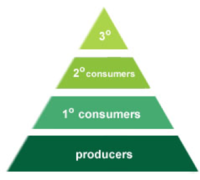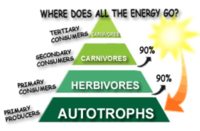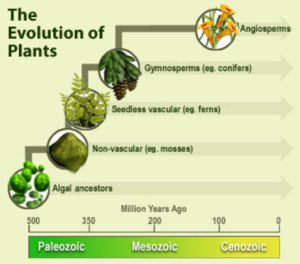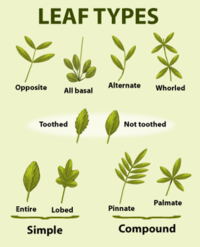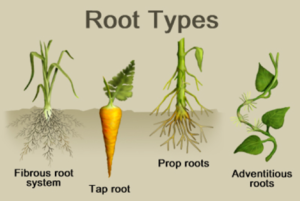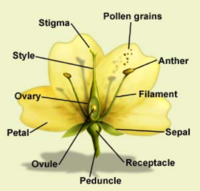Of the more than 260,000 different species of plants, the vast majority are flowering plants – known scientifically as angiosperms. Bryophytes (mosses), pteridophytes (true ferns), and gymnosperms (conifers) make up the small minority of other plants.
Bryophytes have adapted themselves to living on land without having to be constantly submerged, but are not considered to be the ancestors of vascular land plants. However, they are recognized as the earliest land plants and are well adapted to moist habitats. Bryophytes have a simple structure and lack the specialized tissues of vascular plants, such as leaves, roots, and vascular tissue. Despite this, one group of Bryophytes, the mosses, have been able to dominate large parts of the earth's surface. In fact, one genus of moss, the peat mosses (Sphagnum spp.), cover a full 1% of the entire surface of the planet! Not surprisingly, mosses are abundant and widespread throughout the Arctic.
Plant Biology
|
|---|
|
The pteridophytes are vascular plants (they have both phloem and xylem) that depend on spores for dispersal rather than seeds. Pteridophytes require moist environments, so most are found in tropical regions, such as the rainforests of South America. The most well-known group are the ferns, but pteridophytes include the club mosses, spike mosses (neither of which are true mosses), and the horsetails. Unlike ferns, the other groups are practically living fossils with only a few examples left today. These plants were the dominant form of life during the Carboniferous Period – 300 million years ago. Like bryophytes, the ferns and fern allies have alternating generations – one generation is sexual, the next asexual, and so on. What most people classify as a fern is actually only the sporophyte (asexual) generation! In contrast to the ferns, conifers and their relatives (gymnosperms) are found mainly in cold northern environments where they form the dominant vegetation. In terms of complexity, they are a step above the pteridophytes. Gymnosperms do not have alternating generations, nor do they rely on spores to disperse their young. Instead, the male gametes, called pollen grains, are contained within protective structures. The female gametes are contained within their own protective structures, which are then housed inside another structure commonly known as a pine cone. The pollen of gymnosperms is mainly airborne, so the physical structure of the female cone is such that it channels air inwards towards the waiting female gamete (the ovule). Once the ovule has been fertilized, a winged seed develops which can be carried for a long distance on the wind. The flowering plants (angiosperms) are the most complex and most successful of all the groups. In fact, they dominate most terrestrial environments and are a major component of the planet's biomass. They are also the most important group of plants in terms of human use – we are dependent on them for food, medication, building material, fuel, and the list goes on. Angiosperms are divided into two groups, the monocots and dicots, which are differentiated by a number of characteristics. The monocots have an embryo with a single cotyledon – the first leaf or one of the first pair of leaves developed by the embryo – while dicots have two cotyledons. Monocots usually bear parallel-veined leaves and floral organs that are arranged in three or multiples of three. A dicot can also be distinguished by its floral organs – arranged in cycles of four or five – and by its leaves, which have reticulate venation. Monocots are usually small herbaceous plants, while dicots tend to be larger and woody (i.e., they are trees). Some monocots strongly resemble trees, such as palms and banana plants, but they lack the secondary growth that is characteristic of trees. |
Food Webs
Energy continuously flows through all trophic levels in an ecosystem – green plants fix energy from the sun during photosynthesis; the plants are consumed by herbivores; they, in turn, by carnivores. A trophic level can be defined as one of the hierarchical levels of a food web, in which all organisms on that level are the same number of steps removed from the primary producers (plants and algae).
The measurement of energy/nutrient transfer between trophic levels is an idealized concept, since many organisms feed at more than one trophic level. The varied choices of food are best described using food webs, derived from examinations of the gut contents of organisms. Thus, food chain dynamics are more complicated than one might expect and are usually poorly studied.
Trophic Levels
|
|---|
|
The most generalized concept of biomass or energy transfer is an ecological pyramid. Ecological pyramids are formed by dividing organisms into functional trophic roles as determined by their feeding habits: producers, consumers, and decomposers. The base of the pyramid is comprised of primary producers, such as plants, which synthesize their own food from inorganic raw materials; thus, they do not depend on other organisms for food. These producers are photosynthetic and use light as their energy source. Consumers include herbivores (the plant-eaters), omnivores (the plant- and meat-eaters), and carnivores (the meat-eaters). They depend on producers for food, energy, and oxygen. They obtain energy through the process of cellular respiration, breaking down food molecules that were originally produced by photosynthesis. The herbivores are primary (1°) consumers – they occupy the trophic level above producers – while the secondary (2°) consumers (i.e., carnivores and omnivores) feed on the primary consumers and comprise the next level. Tertiary (3°) consumers are usually always carnivores and occupy the top of the food chain or ecological pyramid because other animals do not eat them. Decomposers, such as bacteria and fungi, derive their energy by breaking down organic molecules present in the bodies of dead organisms at all trophic levels. |
Energy Transfer
|
|---|
|
It is estimated that, on average, primary producers capture only 1% of the solar radiation energy that strikes the earth. As energy flows upwards to the next trophic level, 90% of it is lost. This means that only 10% of the energy that reaches a trophic level is successfully transferred to the next level. Energy is also lost through activities such as respiration, heat, and metabolic waste. As a result, only 1% of the energy from the primary producers actually reaches the secondary consumers! |
Biomass
|
|---|
|
Production is defined as the amount of biomass synthesized per unit of time per unit area. Looking at terrestrial versus aquatic systems, there is little difference in the shape of the pyramids. Production by autotrophs is always greater than that of the herbivores, which is greater than that of the carnivores. However, when talking about biomass (the amount of living matter in a unit area or volume of habitat), these two systems are quite different. If we consider a terrestrial ecosystem, the biomass of plants and trees is far greater than the biomass of deer, moose, and other herbivores. In turn, the biomass of the carnivores that feed on these herbivores is smaller still. The sample biomass in terrestrial systems is a fairly close approximation of annual production, since terrestrial plants are generally larger, have fewer generations per year, and produce new tissue at a slower rate. By contrast, aquatic systems project an inverse biomass pyramid. The production of aquatic primary producers can exceed their mean biomass by over 100 times, as compared to terrestrial systems. Remember that biomass is a static measurement (the mass at any given time), but infers nothing about how many days accumulation it represents. Tiny organisms, such as phytoplankton, tend to have high rates of reproduction and population turnover, thereby increasing production. However, since they are efficiently grazed, their biomass remains low. |
Evolution
It is believed that the earth was originally an aggregation of dust and swirling gases about 4.5 billion years ago. One of the most important events in our planet's history was the origin of plant life – it created conditions that allowed life to continue and paved the way for the evolution of higher organisms. The earliest fossil life forms are 3.8 billion years old and contain simple prokaryotic (without a membrane-bound nucleus) cells. The atmosphere at that time was mostly nitrogen gas, with large amounts of carbon dioxide and water vapour. Since life evolved in these conditions, the major elements of such compounds – namely, carbon, oxygen, hydrogen, and nitrogen – make up 98% of the organic materials in living organisms. However, oxygen did not initially exist on its own, as oxygen gas (O2), so all life existed in an anaerobic environment.
Chaotic Beginnings
|
|---|
|
Since no human was alive to document the events of Prehistoric Earth, much of our information has been pieced together from studies of the fossil record. It is now believed that 4 billion years ago the earth was a very chaotic place; there were violent electrical storms, radioactive substances emitting large quantities of energy, and molten rock and boiling water erupting from beneath the planet's surface. These forces broke apart the simple gases in the atmosphere, causing them to reorganize into more complex molecules. Ultraviolet light then bombarded the surface of the planet, breaking apart the complex molecules and forming new ones. These complex compounds were washed out of the atmosphere by driving rains and subsequently collected in the oceans. |
Early Plants
|
|---|
|
Many organic molecules tend to clump together, so the early oceans probably had clusters of organic molecules that looked like droplets of oil in water and may have been the ancestors of primitive cells. They may also have been the source of energy for early life forms; primitive cells could have used these complex compounds to satisfy their energy requirements. As these early heterotrophs increased in number, the clusters of complex organic molecules started to become depleted. It became more and more difficult to find "food", so competition between cells commenced. Eventually cells evolved that could make their own food from simple inorganic materials. The most successful of these early autotrophs were those that could use solar energy to create their own energy – those that could photosynthesize. The first plant ancestors were simple, blue-green algae that existed in the waters of the oceans. These single-celled organisms probably only contained a small amount of the photosynthetic pigment, chlorophyll, and shared many characteristics with today's animal cells, such as the ability to move by using a flagellum. A modern example of these ancient cells would be Euglena – this small, unicellular organism lacks stiff cell walls and moves with a single flagellum, yet it has chloroplasts like most plant cells. |
The Impact of Plant Evolution
|
|---|
|
Why are plants so important? If plants had not evolved to photosynthesize, life on this planet would be very different. Plants produce their food by photosynthesis, and the most important waste product of this process is oxygen – something that most of the animal life on this planet cannot live without! As the first plants began photosynthesizing, the amount of oxygen in the atmosphere increased. Some of the oxygen in the outer layer of the atmosphere was converted to ozone. Eventually there was enough ozone in the upper atmosphere to effectively filter out the harmful ultraviolet (UV) rays that are highly destructive to living organisms. This allowed organisms to survive in the surface layers of water and on land. Having an abundant supply of oxygen in the atmosphere also allowed other organisms to break down the complex energy-containing molecules formed during photosynthesis by a more efficient pathway called respiration. This yields much more energy, which can be obtained in an atmosphere without oxygen. |
Morphology
Plants have three basic structures: roots, stems, and leaves. Each of these parts are important to the overall functioning of the plant, much like our bodies are dependent on our lungs or heart. However, one important difference between plants and animals is that a plant can lose large parts of itself and still survive. This is an adaptation to the immobile nature of plants and serves to protect the plant from the ravages of herbivorous animals.
Plants are usually spit into two groups – vascular and non-vascular – based on their internal structure. Flowering plants and ferns are considered vascular plants because they possess specialized tissue that is used for water and nutrient transport – the phloem and xylem – whereas bryophytes lack this tissue. Non-vascular plants have only simple tubes of undifferentiated cells for transport.
Phloem consists of cylindrical cells which function in the transport of dissolved organic materials, absorbed through the leaves, to various parts of the plant. Xylem is comprised of cells that transport water and minerals from the roots to the leaves. As the plant matures, xylem cells die and form the wood of trees.
Leaves
|
|---|
|
Leaves are the main photosynthetic organs of the plant. They are divided into two parts: the flattened, broad portion – which is known as the blade – and the elongated stalk that attaches the blade to the stem – known as the petiole. The blade has two layers of chlorophyll-laden cells, which enable food production to take place at a maximum rate. The leaves are also the regions of gas and water exchange with the outside environment, so they are well supplied with vascular veins. These veins are arranged in either a web-like network, known as netted venation, or in parallel rows, called parallel venation. The shape of leaves and the way they are arranged is very specific to each plant. In fact, simply examining their leaves identifies most trees. There are two basic forms of leaves: simple and compound. Simple leaves have one blade with a regular or lobed outline. Compound leaves have blades that are divided into subunits called leaflets. If the leaflets are all attached to the petiole at one point, the leaf is called palmate; if they are attached at different points along the leaf axis, the leaf is known as pinnate. Leaves can be arranged alternately or opposite one another. There are interesting variations of leaves, including spines in cacti and tendrils in various climbing vines. |
Roots
|
|---|
|
Roots are the underground plant organs that are involved in the uptake of water and mineral nutrients, food storage, and anchorage. They grow in a variety of ways, including straight downwards, in the form of a taproot; it serves both to store food and absorb water. Carrots are a good example of a plant with a tap root system. Corn uses prop roots to absorb water, but the roots also grow above ground, from the lower portion of the stem, to provide support. Looking closely at a strawberry plant will reveal many roots that appear to be growing from the leaves and stem. These adventitious roots serve as an additional absorptive system. The extent of root growth in some plants, such as grass, is greatly influenced by the surrounding environment. When rainfall is abundant, the fibrous roots of a grass plant will branch and spread deep into the soil; in times of drought, these roots will grow wider and shallower to maximize their absorption of surface rainfall. Consequently, if you water your grass on a hot, sunny day, the roots will come to the surface to soak up the moisture – the problem is that this exposes them to the scorching rays of the sun and your grass will die! By anchoring them to the soil, roots allow plants to grow on many surfaces that are difficult to colonize, such as fast flowing water or the sides of cliffs. Roots can also be used as a storage structure during periods of drought, for plants such as yams and potatoes (tubers), tulips, onion, daffodils, and garlic (bulbs and corms), cattails, blueberries, and rhubarb (rhizomes), and English ivy or strawberries (runners). The internal structure of a root is usually much like a drinking straw, with an outside layer that protects the water carrying phloem and xylem within. At the tip of each root is a root cap, which protects the delicate growing tissues behind it and allows the root to push downwards through the soil. Behind the root cap is the primary growing section of the root, which is known as the root apical meristem. This section gives rise to all of the internal cells of the root, including both phloem and xylem cells. The stem is the cylindrical axis of the plant and acts as a supporting mechanism for the leaves. In more primitive plants such as mosses the tissues within the stem are undifferentiated, but in more advanced plants, such as the angiosperms (flowering plants), there are specialized vascular tissues known as phloem and xylem. In more complex plants, structures like bark and wood come from the secondary growth of these tissues. |
Flower Types
|
|---|
|
Flowers are the sexual reproductive organs of the angiosperms (flowering plants). They usually consist of male parts – the stamen and anthers – and female parts – the stigma, style, and ovary. Petals and sepals surround these parts; the sepals are like modified leaves and enclose the flower to form a protective structure called the calyx. Once the flower is ready, the sepals burst open and the flower is released. The petals, which collectively form the corolla, are often brightly coloured and act as an advertisement for pollinators. Not all flowers contain both male and female parts because the danger of self-fertilization could lead to genetic problems in future generations. Some plants separate the male and female parts by having two types of flowers on each plant. Others have separated them by having each part mature at a different time. Still others have gone so far as to have only female flowers on one individual plant and males on another. Flowerheads vary greatly in size and shape, which is useful in identifying certain species. In fact, most plant families are categorized based on each species having the same flower type. For example, all members of the daisy family (Asteraceae) have dense heads. Orchids are distinctive because of their irregular flowerheads. |
Photosynthesis
Photosynthesis is the process by which plants convert light, carbon dioxide, and water – in the presence of the green pigment, chlorophyll – into food or energy. It is extremely important for the majority of life on earth because plants convert inorganic (unusable) carbon into an organic (useable) form. Most of the carbon found on the planet is in an inorganic form, such as carbon dioxide (CO2), bicarbonate (HCO3-), and carbonate (CO3-2). Plants alter the carbon found in these compounds and store it as organic carbon compounds. Aquatic plants are especially important in this process because they account for 40% of the photosynthesis on the planet, though they are less than 1% of the plant biomass!
How it Works
|
|---|
|
Photosynthesis can be divided into two stages. The first stage is light dependent; it needs the energy collected from sunlight to proceed, which is then used to produce ATP – the energy unit of the cell. The second stage is light independent; the energy that has been captured in ATP is used (along with other factors) to create glucose, a simple sugar. The conversion of carbon dioxide into organic carbon compounds is called carbon fixation. The light reactions of photosynthesis are associated with or occur in membranes. The rest of the reactions occur in the aqueous phase (i.e., not in membranes). Eukaryotic cells have special organelles called chloroplasts, in which photosynthesis takes place. The molecules of cholorphyll and carotenoid pigments are contained within the membranes of flattened sacs called thylakoids. In many higher plants, these sacs lie close together in structures called grana; a single granum looks like a stack of coins. In most anaerobic photosynthetic bacteria and cyanobacteria, the light reactions occur on membranes that are arranged in sheets of lamellae next to the periplasmic membrane. The dark reactions generally occur in the centre of the cell. |


